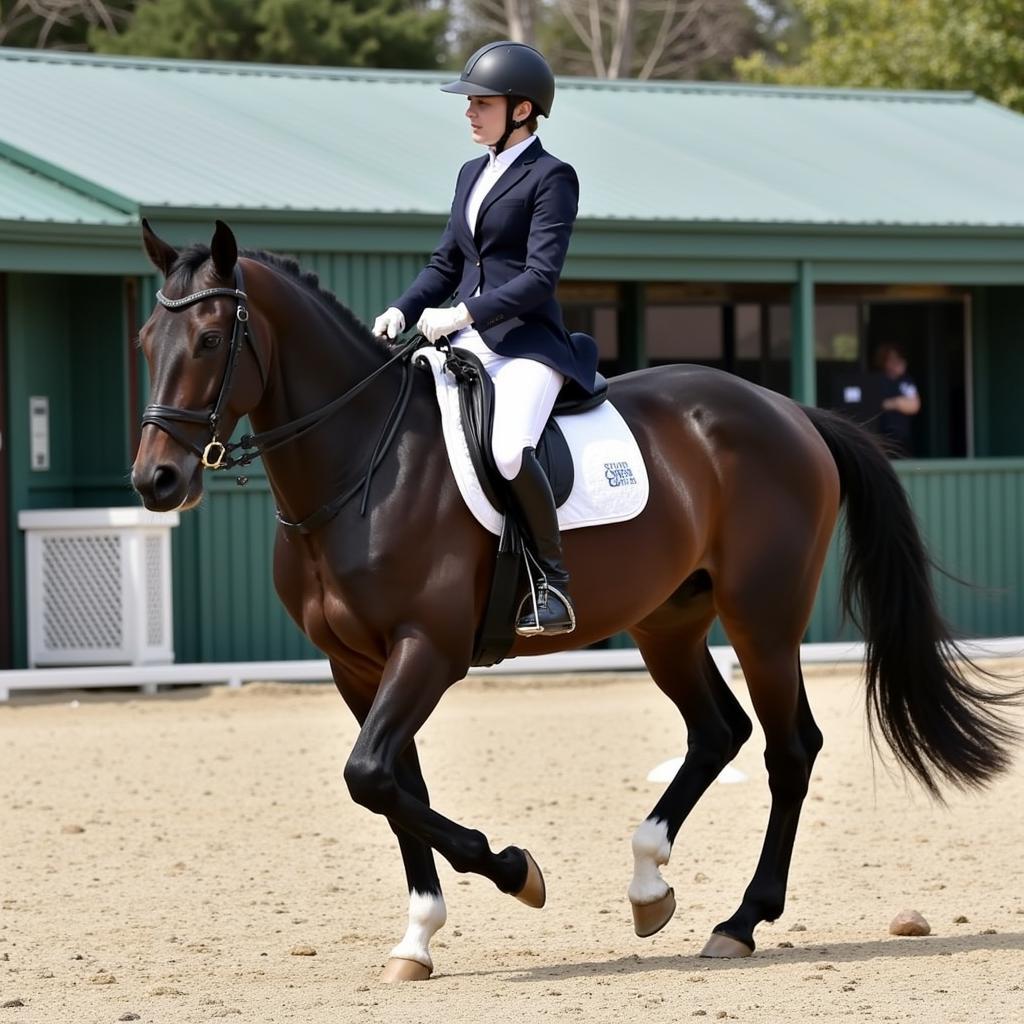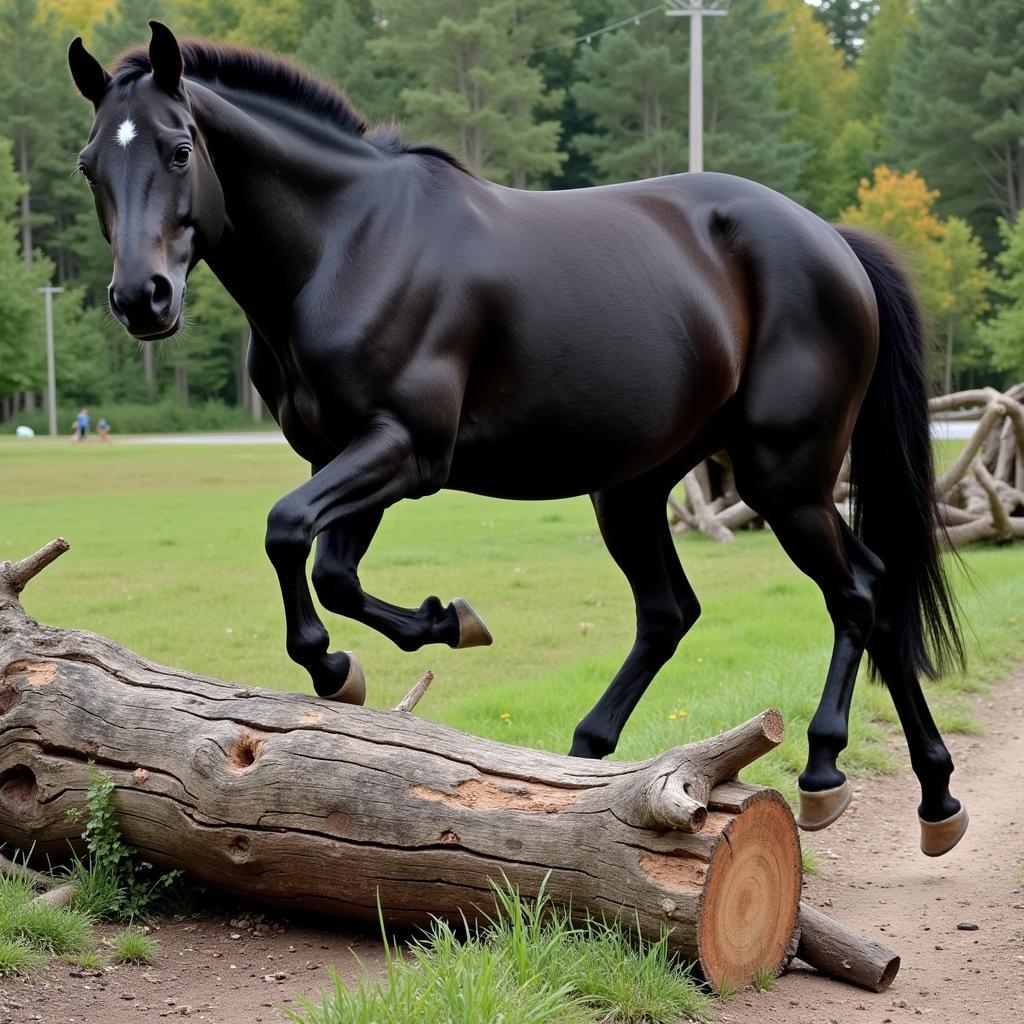The term “Black Horse Side Steps” might pique the curiosity of horse enthusiasts, conjuring images of a dark steed performing a specific maneuver. However, it’s important to understand that this phrase isn’t a standardized equestrian term describing a particular gait or movement. Instead, it’s a combination of descriptors that could indicate various behaviors depending on the context.
Let’s delve deeper into understanding what might be implied by “black horse side steps” and explore common equine lateral movements.
Decoding “Black Horse Side Steps”
When encountering the phrase “black horse side steps,” we need to break it down:
- Black Horse: This simply refers to the horse’s coat color, which, while visually descriptive, doesn’t inherently dictate movement.
- Side Steps: This suggests a lateral movement where the horse moves its legs sideways rather than in a forward stride. However, without further context, it’s impossible to pinpoint the exact movement.
The ambiguity arises because various gaits and maneuvers involve side steps. To gain clarity, consider the context where you encountered this phrase. Was it within a specific training discipline, a fictional narrative, or a casual conversation?
Common Equine Lateral Movements
While “black horse side steps” lacks a precise equestrian definition, several established lateral movements might be associated with the phrase:
- Leg Yielding: A fundamental training exercise where the horse travels both forward and sideways, maintaining a slight angle to the direction of movement.
- Side Pass: A more advanced lateral movement where the horse moves sideways with its body relatively straight, stepping its crossed legs over each other.
- Half Pass: Performed on a diagonal line, the horse bends slightly around the rider’s inside leg while stepping sideways and forward.
- Shoulder-In: A collected movement where the horse’s shoulders move slightly inward towards the direction of travel while maintaining a forward stride.
 Black Horse Performing Leg Yielding
Black Horse Performing Leg Yielding
Each of these movements requires specific training and aids, and a “black horse side stepping” could be a simplified way of describing one of them.
Understanding Behavior Through Movement
Beyond formal gaits, horses often use side steps in everyday behavior. A horse might sidestep to:
- Avoid an obstacle: A puddle, a low branch, or even a patch of uneven ground might cause a horse to side step out of the way.
- Display dominance: In a herd setting, a horse might side step towards another, pushing them aside to assert their position.
- Express discomfort: A horse experiencing pain or discomfort, perhaps from an ill-fitting saddle or an injury, might side step to alleviate pressure.
 Black Horse Sidestepping Obstacle
Black Horse Sidestepping Obstacle
Observing the context and accompanying body language are crucial to understanding why a horse might be side stepping.
When to Seek Professional Guidance
If you’re unsure about the “black horse side steps” context or notice your horse frequently exhibiting this behavior, seeking professional guidance is essential. A qualified trainer or equine veterinarian can:
- Assess your horse’s movement to determine if the side stepping indicates a training opportunity or an underlying physical issue.
- Recommend appropriate training exercises to refine desired lateral movements or address any behavioral concerns.
- Identify potential health problems that might be causing discomfort and suggest treatment options.
 Veterinarian Examining Horse's Legs
Veterinarian Examining Horse's Legs
Remember, understanding your horse’s movement is key to ensuring its well-being and developing a strong partnership. While “black horse side steps” might be a descriptive phrase, seeking clarity and professional guidance is always recommended when interpreting equine behavior.
Conclusion
While “black horse side steps” doesn’t have a specific meaning in the equestrian world, it opens the door to exploring various equine lateral movements and their significance. Understanding these movements and the reasons behind a horse’s side stepping can enhance your horsemanship skills and ensure the well-being of your equine companion.
Remember, observing your horse’s movement, seeking professional guidance when needed, and continuing your education are all essential steps on the path to becoming a knowledgeable and responsible horse owner.
For more insightful articles on horse care, training, and equestrian lifestyle, explore our other resources at Justus Horses USA.
Need expert advice on horse care?
Contact us today!
Phone: 0772127271
Email: [email protected]
Address: QGM2+WX2, Vị Trung, Vị Thuỷ, Hậu Giang, Việt Nam
Our dedicated team is available 24/7 to assist you.